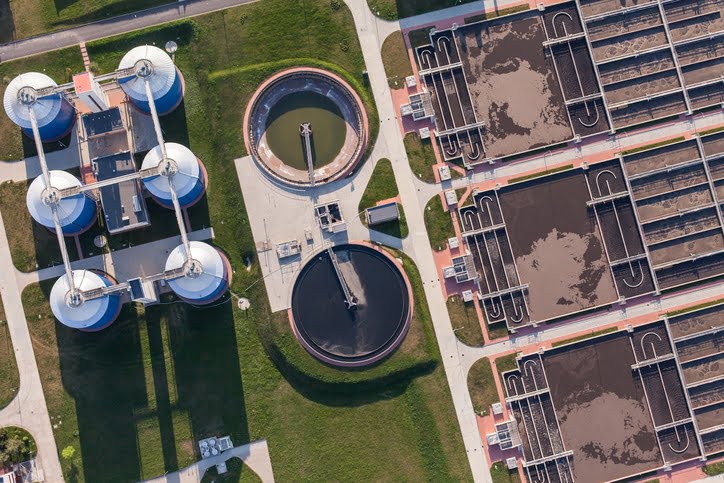Closed Loop Cooling Systems in Wastewater Treatment: 3 Big Mistakes

Wastewater treatment facilities present unique hazards to electrical enclosures. Extremely harsh conditions commonly present during wastewater treatment include highly corrosive liquids, gases and vapors such as chlorine, hydrogen peroxide, and ammonia. Some enclosures may also encounter salt spray and possibly even flammable gases generated by the decomposition of waste.
Equipment inside enclosures is often made with carbon steel support structures, which are highly susceptible to corrosion. Electrical contact material may become tarnished and may also suffer corrosion, leading to contact overheating and burning, while low voltage contacts can fail to close.
These hazards mean that wastewater treatment plants should typically follow the NEMA 4X standard, which specifies that an enclosure be fully sealed to keep out corrosive vapors and liquids.
But protecting electrical components by placing them inside a sealed enclosure presents another problem: overheating due to inadequate heat dissipation. Working components give off waste heat due to inefficiency. Because they are designed to operate best within a specific range of temperatures, the enclosure requires some type of cooling system to maintain the interior within that range.
Successful selection of the right enclosure cooling system for a wastewater treatment plant can be derailed by any of the following big mistakes.
Mistake #1: Choosing an open loop cooling system
Enclosure cooling systems come in two basic types: open loop or closed loop. Open loop systems work by directly exchanging hot air surrounding the components inside the enclosure with cooler air from outside—usually by a filtered fan system.
However, relying on fans that blow ambient air directly into the enclosure to cool electrical equipment would be a big mistake. When it comes to preventing harmful contaminants from reaching sensitive electrical components, the use of a closed-loop cooling system is the only option.
A closed loop cooling system is one in which air inside the electrical enclosure has no direct contact with outside air. Rather than blowing air into it, a closed-loop system transfers heat from inside to outside a sealed enclosure. This insures that the enclosure is not contaminated with ambient air, dirt, chemicals, dust, moisture or foreign matter, so that sensitive components are protected and are kept at the required operating temperature.
All NEMA 4X enclosures—along with NEMA 12 and NEMA 4 types—require closed loop cooling to prevent contaminants, corrosive gases, solids, or liquids, from reaching the electric components within.
Mistake #2: Choosing the wrong type of closed loop system
Two basic types of closed loop cooling systems are the air conditioner and the air to air heat exchanger. Both have benefits and drawbacks to be considered when selecting an enclosure cooling system for a water/wastewater treatment plant.
An enclosure air conditioner presents an extremely effective method of cooling. In an air conditioner, heated air from the sealed enclosure is drawn out, passed through an evaporator coil which cools it, and is then returned to the enclosure without ever encountering the outside air. Air conditioners are very effective, though they cost more to own and operate than any other type of cooling system.
An air to air heat exchanger is a closed loop cooling solution which has the potential to cool an enclosure to a temperature slightly higher than the ambient air temperature. Apart from air circulation fans, it contains no moving parts and energy consumption is extremely low, meaning annual operating costs are low.
The heart of the air to air heat exchanger is a passive heat pipe which transfers heat from inside the enclosure out to the ambient air using a chemical refrigerant. With a few limitations, an air to air heat exchanger is suitable for many cooling applications, and heat exchangers are available for cooling NEMA 12, 4, and 4X enclosures.
But in situations where the components in the enclosure must operate at relatively low temperatures, or where ambient temperatures are quite high—such as outdoors in a hot climate—an air to air heat exchanger will not be able to maintain the enclosure within the manufacturer’s specifications.
In these cases, the best choice will be an enclosure air conditioner, which will work efficiently even if the ambient temperature is much higher than the enclosure’s required air temperature. An air conditioner will also control humidity much better than a heat exchanger, which can be helpful for reducing the humidity around electrical and electronic equipment that is sensitive to moisture.
Mistake #3: Improperly sizing the cooling system
The final big mistake often made in selecting an enclosure cooling system for a wastewater treatment facility is specifying the wrong size for the system. If the system does not have a cooling capacity high enough to maintain the electrical equipment within its specified temperature range, the equipment will quickly begin to lose efficiency.
On the other hand, specifying a cooling system that is too large will not only cost more than necessary, but can also cause problems because it will not run long enough to condense out the humidity in the air, leading to damage for some electrical equipment. It may also shorten the equipment life and reduce efficiency by cycling off and on too frequently and causing wide temperature swings.
Choosing the right enclosure cooling solution, including upgrades for corrosion resistance, and then sizing it correctly and maintaining it properly, will protect valuable equipment, save money and reduce downtime for a water or wastewater treatment plant.
For help in selecting the best enclosure cooling system for your application, visit this online Enclosure Temperature Management calculator. The ETM calculator takes into account various factors such as heat load, enclosure size and location, and ambient temperature. The results will determine if the application can be sufficiently cooled by the use of an air-to-air heat exchanger or will require an enclosure air conditioner.
If you need more help in choosing and sizing the optimal enclosure cooling system for your water or wastewater treatment facility, contact the experts at Thermal Edge.

